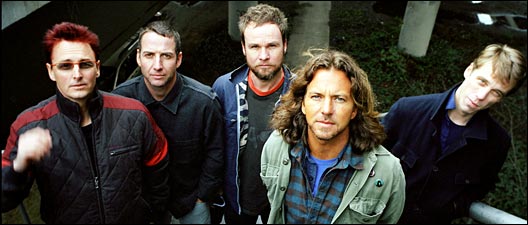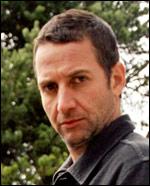
Pearl Jam.
Photo: Danny Clinch.
Stone Gossard, hard-rock guitarist and founding member of Pearl Jam, has a soft spot for the environment. Maybe it’s the water-meets-mountains scenery surrounding his Pacific Northwest home. Or that name of his. But the guy knows green. He’s even got his own pimped-out 1982 Mercedes Benz, which runs on used vegetable oil and “smells a little bit like a wonton.”
Lately, though, Gossard’s been rollin’ in a biodiesel-fueled bus, touring the country to promote the band’s newest album, Pearl Jam. And he’s been using all that time on the bus to think about how, as a business, the group can help advance a culture that is responsive to the environment and rewarded for positive new ideas.
Never ones to shy away from taking a stand — whether in lyrics (their recent single “Worldwide Suicide” is a blatant swipe at Bush) or in front of Congress (Gossard and bassist Jeff Ament appeared before a subcommittee during a dispute with Ticketmaster in 1994) — Pearl Jam recently announced a major green project. Their Carbon Portfolio Strategy is intended to offset the impacts of their latest tour — which heads from the U.S. to Europe and Australia later this year — by donating a total of $100,000 to nine organizations doing work around climate change and renewable energy.
Last week, Gossard found time between a sound check and a club show in Hollywood to talk with Grist. The down-to-earth (literally) rock star shared his thoughts about addressing the band’s carbon-heavy lifestyle, trumpeting the work of grassroots nonprofits, and hoping these latest moves resonate with fans.

Stone Gossard.
Photo: Danny Clinch.
Let’s chat about your Carbon Portfolio Strategy — how did that come about?
As a business, we’ve been looking for different ways of acknowledging and mitigating our carbon use. When we tour, we’re on airplanes, we’re on buses, we’re in a lot of vans, a lot of cars. [We use] a lot of electricity in hotels, a lot of electricity at venues. [There are] a lot of vehicles coming to and from the venues. The venues use a lot of power, and almost all of that power is carbon-oriented.
On the last tour, we did a deal with Conservation International where with some $50,000 of the band’s money, we were able to help fund the preservation of some 800 hectares of Madagascan rainforest that would have been cut down either for palm-tree plantations or slash-and-burn agriculture — our theory being that keeping intact rainforest on the ground is another great way of keeping carbon out of the atmosphere. This tour, we wanted to expand that and we wanted to also highlight the work that different groups are doing in terms of dealing with carbon. These nine groups that we picked — three or four of them are from the Pacific Northwest region and there are some national groups, some policy groups, some initiative stuff, and some international stuff.
One element of it is a replanting of 40 or 50 hectares of rainforest down in Ecuador that will be part of a preserve using 15 species of hardwoods and a lot of native flora and fauna. It’s an actual reforestation experiment, which I’m very excited about. Plants are amazing in terms of how much carbon they absorb and that seems like it should be a real fundamental part of anybody’s strategy: to get more forests replanted with the kinds of plants that grow naturally in that region.
And then there’s a big component of trying to promote and accelerate the technological side of clean, renewable energy. So we worked with Bonneville Environmental Foundation and NativeEnergy, both of whom do green tags, which is basically a way of getting more clean, renewable energy into the grid. It gives people an opportunity to pay a premium for clean, renewable energy.
We are looking for a sort of synergistic approach in terms of getting attention and getting a lot of people talking about it and showcasing how there are a lot of different ways you can address the issues of carbon.
How did you narrow it down and choose the nine organizations?
I just kind of winged it. Over the last 10 years, I’ve had an opportunity to look around at the landscape of all the different groups working on this kind of stuff. For instance, the Cascade Land Conservancy is a group that [helped us, along with Soundgarden, buy] a piece of land and create an easement about 10 years ago up in the Cascade foothills. We basically went in and bought the land in an open auction where people were potentially going to mine it. So we’ve had a long history with them.
I think EarthCorps works on the greenbelts right in my neighborhood. So does the Cascade Land Conservancy. I know a lot of the work they do.
I’m familiar with IslandWood and have spent some time there before and seen their operations. I think they’re fantastic.
Conservation International, obviously, we’ve done work with in the past.
American Solar Energy Society — I’m aware of them through Tom Starrs who works at the Bonneville Environmental Foundation.
There could be a list of another 10 or 15 groups that are all doing other work that’s equally as important, but these are the ones we knew and were familiar with.
I noticed that Grist isn’t on the list …
Now they will be.
That would be great. So your last tour resulted in about 5,700 tons of carbon emissions. How does this tour compare?
I think we’re going to be a little lower on this tour. Using the biodiesel’s gonna bring our footprint down considerably because it has about half the carbon output that normal diesel does. And we’re being more efficient in terms of where we’re flying and how we’re doing that. The number of fans going to and from was also part of our calculation — you know, average fan with a car and maybe two or three people going to the show from 10 or 15 miles away … I think our carbon footprint’s gonna still be up there, but it’s going to be lower, and we’re gonna keep trying to get it lower every tour, if we can.
And you’ve encouraged your fans to offset their own footprints?
We are gonna try to offset the single trip of our fans going to and from the show, but each of our fans, if they wanted to find out what their own personal carbon footprint was over the course of their year, they could find it out.
What about the political angle? You talked to Congress about Ticketmaster a decade ago — what would you say to them now about global warming?
Well, I don’t know what I would say. In terms of the politics of it, I just feel more comfortable thinking about it in terms of our own band and what we’re trying to do.
In the long run, we need to come up with energy plans that are neutral with our environment or that really don’t affect it as much. I’m very excited about the possibility of the world moving toward more renewable energy.
As part of the Vote for Change Tour a couple years ago, you helped raise $77,000 for a number of renewable-energy projects. Are any of those efforts still ongoing?
A lot of those projects that were formulated and funded during the Vote for Change Tour are just now coming online — I think there are five or six different ones. Most of them were solar demonstration projects in schools and community centers. They’re not powering buildings but they’re getting people’s minds to see solar as a possibility. Solar is expensive now, and a lot of people talk about how expensive it is. But if it was scaled up and if there was support for it, I think it ultimately would be a fantastic alternative, particularly in the Sunbelt where there’s an incredible amount of power available to people in the form of solar power.
I was recently at the Bonnaroo Music Festival in Tennessee and they used solar panels to power one of the smaller stages.
Interesting. How was the sound?
It was good. Have you guys thought about moving in that direction at all? Or, as you said, too expensive for now?
We have to strike a balance in terms of all this stuff. But in terms of how do you power an entire tour without burning any carbon? We’re a ways away from that because the technology is a ways from that. We believe that ultimately there’ll be opportunities to get there, but we need a lot of businesses and a lot of leaders to agree that we need to move there collectively, because that’s where you really start to get the cost benefits of having a lot of people all move at once, and where mass manufacturing can start to bring the cost down of some of these technologies. We’re gonna do everything we can to try to get Pearl Jam to net-zero emissions. And ultimately, we’d love to see a lot more clean-energy technology all over the place because it’s the way of the future for sure. But we’re not there yet.
As you’re traveling the country or over in Europe, do you feel like the reception to your ideas about these issues varies?
Europe in general is way ahead of America in terms of beginning to formulate long-term strategies for getting the economy to move toward more carbon consciousness, move toward technologies that aren’t as carbon intensive or that don’t use carbon at all. So … I’m assuming that they’re gonna look at this as being like, “Yeah, that’s what you should be doing, because you’re a responsible business.” Whereas in America, I think there’s not quite as much awareness of it, and therefore maybe even the ideas themselves are brand new to some people and are just sort of beginning to resonate.
So, if my sources are correct, your 40th birthday is coming up [it was July 20] — so happy birthday!
Yeah, thanks!
Thinking about that, 40 is kind of the mid-life crisis …
Oh God, I’ve got to get a Porsche and divorce my wife.
[Laughs.] What do you see ahead for yourself and for your environmental activism?
Right now, the thing I’m most excited about is this carbon portfolio and what is possible with this variety of groups — finding an avenue, a mechanism for them to effect change both locally and nationally. When you have a variety of groups like this, all of them doing the work in different ways, you have some really great opportunities for some synergy and innovation and taking it to a new level. I’m really hopeful that this carbon portfolio can continue on and that we can be part of raising this entire group of organizations to a higher level and really draw more attention to the work they’re doing.
And I’m happy as a clam. I’m in a fantastic band with people who I love and friendships that I’ve had for a long time, and we’re still growing and learning about each other and figuring out how to communicate with each other. I couldn’t be having more fun in terms of being a band and discovering what that’s all about. I’m a young 40-year-old kid at this point, and nobody’s told me I have to go back to school yet, so I’m continuing on with summer vacation.

One last question: The cover art on your new album is an avocado — is it organic?
You know, I don’t know whether it is or not. [Laughs.] But the California avocado people have been giving us cases of avocados lately because they say avocado sales have been going through the roof.
